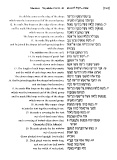Page 578 - SHMOT
P. 578
#
[581] #26015-EYAL - 26015-SHMOT-EYAL | 19 - B | 18-07-18 | 09:55:48 | SR:-- | Yellow 26015-EYAL - 26015-SHMOT-EYAL | 19 - B | 18-07-18 | 09:55:48 | SR:-- | Magenta 26015-EYAL - 26015-SHMOT-EYAL | 19 - B | 18-07-18 | 09:55:48 | SR:-- | Cyan 26015-EYAL - 26015-SHMOT-EYAL | 19 - B | 18-07-18 | 09:55:48 | SR:-- | Black #26015-EYAL
Shemos—Pekudei 38:23–26 åëYâë:çì éãå÷ôZúåîù
Shemos—Vayakhel 36:11–21 àëYàé:åì ìä÷éåZúåîù
23. With him was Oholiav, son of Achisamach, C§ÖôÖ½−ÞÌìÎê-öÓaë„Öê−ÌñÏíÞÖêB †zÌêÐî .è× He did the same on the edge of the drape í flÖ¼−ÌþÐ−Ôí³¤ÔõÐNÌa ·íÖNÖ¼ö¥Ñk
of the tribe of Dan, sculptor and craftsman, ë¢ÑLìÐîL¤ÖþÖìö£Öð-íÑhÔôÐñ which was the innermost end of the second group. :³−ÞÌòÑMÔí³Óþ£ÓaÐìÔnÔaíflÖòB®−¤ÌwÔí
and embroiderer in greenish-blue wool, ·³Óñ¶Ñ×ÐzÔaó†ÑšÒþÐî 12. He made fifty loops on (the edge of) one drape ›³ÖìÓêÞÖíí¤Ö¼−ÌþÐ−Ôa ‡íÖNÖ¼³Ò †êÖñÞŠñó−¤ÌMÌôÎì .ë−
dark red wool, crimson wool, −£ÌòÖMÔí³Ô¼'ÔñB³Ðëe ö flÖôÖbÐþÔê¤Öëe and he made fifty loops on the edge of the drape í flÖ¼−ÌþÐ−Ôíí¤Ñ®ÐšÌa ·íÖNÖ¼³Ò †êÖñÞŠñó−¤ÌMÌôÎìÞÔî
and fine linen. ñ :LÞÑMÔëe which was on the second group. ³−¢Ì òÑMÔí³Óþ¤ÓaÐìÔnÔaþ£ÓLÎê
24. All the gold that was used for the work í flÖ×êÖñÐnÔñ ·−eNÖ¼ÞÓíë†ÖíÖfÔí-ñÖk .ð× The loops were opposite one another. :³ÞÖìÓê-ñÓê³£ÔìÔê³Ò flêÖñŠlÔí ·³G−ÌaКÔô
in all the work of the Sanctuary. LÓðÒ¢wÔí³Ó ×ê¤ÓñÐôñÒ£×Ða 13. He made fifty golden clasps ë¢ÖíÖï−¤Ñ½ÐþÔšó−£ÌMÌôÎìNÔ¼–ÔiÔî .è−
The gold donated as a wave offering amounted to í†ÖõeòÐzÔíë¤ÔíÐï|−¤ÌíÐ−Ôî and he joined the drapes (of each group) together ·³ÔìÔê-ñÓê³¥ÔìÔê³Ò‚¼−ÌþÐ−Ôí-³Óêþ¶ÑaÔìÐ−Ôî
twenty-nine kikar þ flÖkÌk ·ó−ÌþÐNÓ¼Ðî¼ÔL¥Ñz with the clasps. ó− fl̽ÖþÐwÔa
and seven hundred and thirty shekel, ñÓš£ÓLó−§ÌLñÐLe ³B«êÑô¼¶ÔëÐLe The mishkon was thus one unit. ô :ðÞÖìÓêö£ÖkÐLÌnÔí−'ÌíÐ−Ôî
(measured) by the Sanctuary standard. :LÓðÒ ÞwÔíñÓš'ÓLÐa 14. He made drapes of goats’ hair ó−flÌf̼³Ò¤¼−ÌþÐ−·NÔ¼¶ÔiÔî .ð−
25. The silver (collected) by the community census í£ÖðѼÞÖí−'ÑðešÐt¹Ó½§Ó×Ðî .í× for a covering over the mishkon. ö¢ÖkÐLÌnÔí-ñÔ¼ñÓíÒ£êÐñ
(amounted to) one hundred kikar, þ¢ÖkÌk³¤ÔêÐô He made eleven such drapes. :óÞÖ³Òêí'ÖNÖ¼³Ò£¼−ÌþÐ−í'ÑþÐNÓ¼-−ÞÑzÐLÔ¼
and one thousand seven hundred ³B‚êÑô¼¶ÔëÐLe »¹Óñ»ÓêÐî 15. The length of each drape was thirty amohs, í flÖnÔêÞÖa ·ó−ÌLñÐL³†ÔìÔêÞÖíí¤Ö¼−ÌþÐ−ÔíCÓþÒ‚ê .î¬
and seventy-five shekel, ñÓš£ÓLó−§Ì¼ÐëÌLÐîí«ÖMÌôÎìÞÔî and the width of each drape was four amohs. ³¢ÖìÓêÞÖíí¤Ö¼−ÌþÐ−ÔíëÔìÒ£þ³B flnÔ꼤ÔaÐþÔêÐî
(measured) by the Sanctuary standard, :LÓðÒ ÞwÔíñÓš'ÓLÐa The eleven drapes were of the same measure. :³Ò Þ¼−ÌþÐ−í£ÑþÐNÓ¼−'ÑzÐLÔ¼Ðñ³ flÔìÔêí¤ÖcÌô
26. one beka per person, ³ÓñÕflbÐñŠbÔñ¼ÔšÓaƒ.î× 16. And he joined together five drapes by themselves, ð¢ÖëÐñ³Ò£¼−ÌþÐ−ÔíL'ÑôÎì-³Óêþ§ÑaÔìÐ−Ôî .ï¬
(the equivalent of) a half-shekel, ñÓš£ÓMÔí³−'Ì®ÎìÞÔô and six drapes by themselves. :ðÞÖëÐñ³Ò£¼−ÌþÐ−ÔíL'ÑL-³ÓêÐî
17. He made fifty loops on the edge of one drape í flÖ¼−ÌþÐ−Ôí³¤ÔõÐNñÔ¼ƒó− †ÌMÌôÎì³Ò¤êÖñÞŠñNÔ¼‚ÔiÔ î .ï−
AAAAAAAAAAAAAAAAAAAAAAAAAAAAAAAAAAAAAAAAAAAAAAAAAA RASHI é"ùø AAAAAAAAAAAAAAAAAAAAAAAAAAAAAAAAAAAAAAAAAAAAAAAAA which was the innermost end of the (first) group ³Óþ¢ÖaÐìÔnÔaí£ÖòÒ®− ÞÌwÔí
and he made fifty loops on the edge of the drape í flÖ¼−ÌþÐ−Ôí³¤ÔõÐN-ñÔ¼ ·íÖNÖ¼³Ò †êÖñÞŠñó−¤ÌMÌôÎìÞÔî
[24] Kikar. .øÈkÄk [ãë]
A kikar is the equivalent of 60 maneh ,íÓòÖôó−ÌMÌL which was on the second group. :³−ÞÌòÑMÔí³Óþ£ÓëÒìÞÔí
and the maneh associated with the Sanctuary LÓðÒšñÓLíÓòÖôe 18. He made fifty copper clasps ó−¢ÌMÌôÎì³ÓL£ìÐò−'ѽÐþÔšNÔ¼§ÔiÔî .ì−
was double [the weight of a common maneh] ,íÖ−Öí ñeõÖk to join the tent together making it one. :ðÞÖìÓê³Ò'−ÐíÞÌññÓíÒ£êÖí-³Óêþ'Ñ aÔìÐñ
making the kikar equal to 120 [common] maneh, ,íÓòÖô ×"š þÖkÌkÔí−ÑþÎí
19. He made a covering for the tent ñÓíÒ flêÖñ ·íÑÓ½Ð×ÌôNÔ¼¥ÔiÔî .¬−
A maneh is equal to 25 selaim (shekalim), ,ó−̼Öñн í"× íÓòÖnÔíÐî
out of red dyed rams’ skins, ó−¢ÌôÖcÖêÐôó£Ìñ−Ñê³Ò'þÒ¼
making the kikar of the Sanctuary LÓðÒšñÓLþÖkÌ×−ÑþÎí
3,000 shekalim (25 x 120 = 3,000). ,ó−ÌñÖšÐL ó−ÌõÖñÎê³ÓLñÐL and a covering of tachash skins above that. ñ :íÖñмÞÖôÐñÌôó−£ÌLÖìÐz³Ò'þÒ¼í§Ñ½Ð×Ìôe
It is for this reason that it counts as units ¬BþЬBþÐõÌëíÖòÖôCÖ×−ÌõÐñ Chamishi (Fifth Aliyah) éùéîç
all the shekalim that add up to less than 3,000, ,ó−ÌõÖñÎê’èÌôóÖòÖ−ÐòÌôÐaö−̳eìÐtÓL ó−ÌñÖšÐMÔíñÖk 20. He made planks for the mishkon ö¢ÖkÐLÌnÔñó−£ÌLÖþÐwÔí-³ÓêNÔ¼'ÔiÔî.×
because they do not add up to a kikar. 13 :þÖkÌ×Ðñö−̼−ÌbÔôö−ÑêÓL
out of acacia wood; ó−£ÌhÌL−'Ѯμ
[26] Beka. .òÇ÷Æa [åë]
(these planks) stood upright (vertically). :ó−ÞÌðÐôÒ Þ¼
This is the name of the weight ñÖšÐLÌôóÑL êeí
21. Each plank was ten amohs long, LÓþ¢ÖwÔíCÓþÒ¤ê³Ò £nÔêþÓN'Ó¼ .ê×
of one half of a shekel. :ñÓšÖMÔí³−Ì®ÎìÔôñÓL
and one and one half amohs í flÖnÔêÞÖí−¤Ì®ÎìÞÔî ·íÖnÔêÐî
was the width of each plank. :ðÞÖìÓêÞÖíLÓþ'ÓwÔíëÔìÒ£þ
13 Bechoros 5a.

